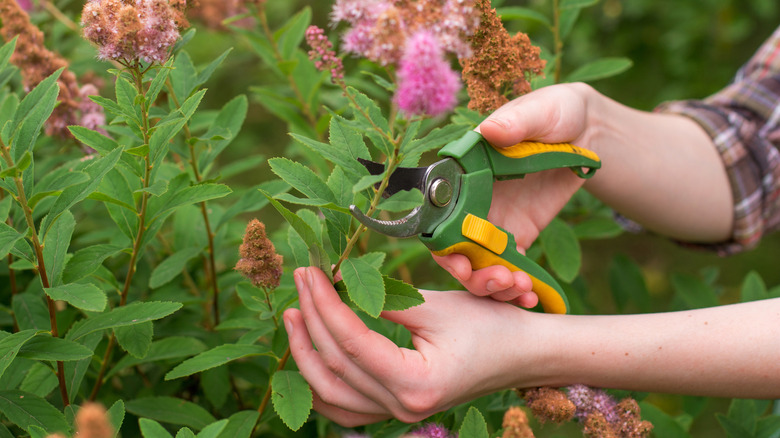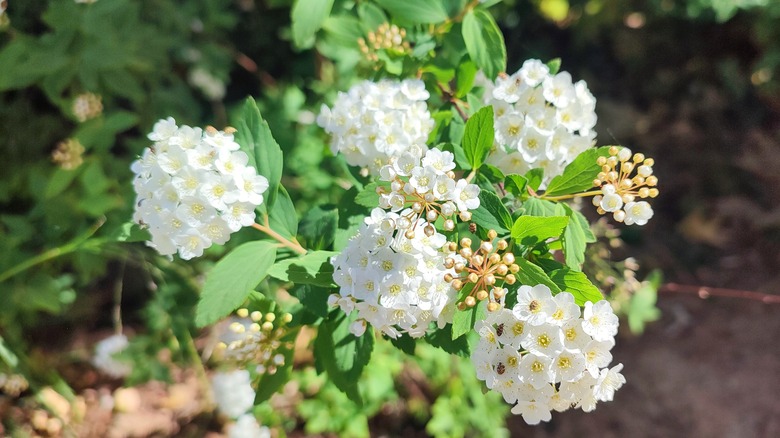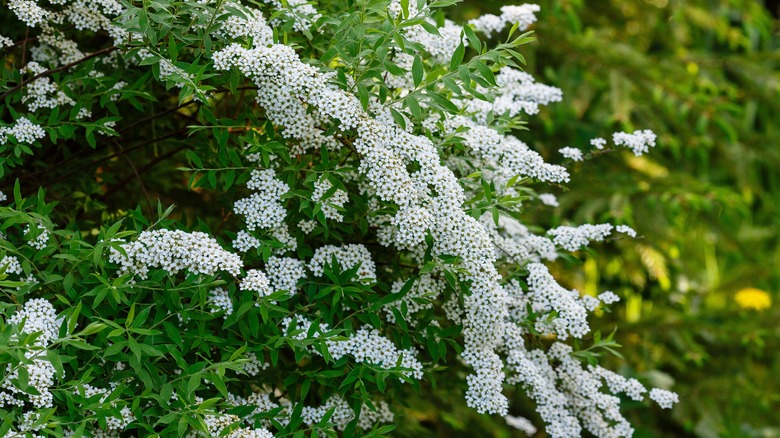The Best Time To Prune Spirea To Keep Its Captivating Blooms Looking Their Best
Spirea (also known as meadowsweet or steeplebush depending on the species) is a genus of flowering shrub that's part of the rose family, and is native to the Northern Hemisphere. It tolerates any soil that's moist but not soggy, can grow in full or dappled sunlight, and is hardy to U.S. growing zones 4 through 8. Some species, like the Vanhoutte spirea or the threelobe spirea, can be grown in zone 3. But if you've already got these beautiful bushes in your yard or garden and they're looking unruly, you might wonder when to prune your spirea, and how to do it. That depends on if you have a spring-blooming spirea or a summer-blooming spirea. Spring-blooming spirea should be pruned after it flowers, while summer-blooming spirea can be thinned throughout winter and early spring. We'll tell you the best way to tame these overgrown shrubs.
While spirea is known for its white, red, or pink blooms and multi-colored foliage that may change color in the fall, we do have a note of caution. If you've got a Japanese spirea (Spiraea japonica), then you should know that it's considered an invasive throughout the eastern U.S. due to its thick growth taking over native plants that cannot compete. Even though many spirea species are non-natives, with notable exceptions being white meadowsweet and the federally threatened Virginia meadowsweet, they aren't all considered invasive. It may be worth it to get rid of your Japanese spirea altogether and replace it with another spirea species.
Prune your spirea bush at the right time for your species
The first thing to know about when to prune your spirea bush is if you've got a spring-blooming or summer-blooming species. You can go by when the flowers bloom, of course, but if you have a young or new plant, you may not be sure — after all, there are over 80 species of spirea. Spring-blooming spirea examples are the Snowmound spirea (Spiraea nipponica), bridalwreath spirea (Spiraea prunifolia), and Vanhoutte spirea (Spiraea x vanhouttei). Summer bloomers include the Blue Kazoo Double Play spirea (Spiraea media) and birchleaf spirea (Spiraea betulifolia).
Spring spirea blossoms on old wood, so pruning too early will prevent flowers from forming. It will benefit from an annual trimor a full renewal pruning, cutting up to ⅓ of any older, bigger branches to the ground every two to three years. When your spring-blooming spirea finishes flowering, go ahead and grab your loppers, focusing on canes that look sickly or dead. This helps your spirea stay healthy and improve its flowers for next year.
However, summer spirea blooms on new wood, and these shrubs are better trimmed when dormant, preferably in the winter or just as spring is starting. During these times, the pruning cuts on spirea will heal more quickly and help it withstand cold temperatures. Overgrown summer-blooming spirea can handle a rejuvenation pruning, removing all canes to improve future foliage. Regardless of which spirea you have, it's a plant you shouldn't be pruning in the fall.
How to continuing caring for your spirea shrub
Once your spirea bushes are all pruned up, there are ways to help it look its best and continue its care. A good mulch is great for maintaining moisture during hotter, drier weather. Consider it as a companion plant for roses to get a showstopping garden of color. Or, if you don't like where your spirea is located — perhaps your shrub is growing in front of high-traffic walking areas or blocking the view out of the window — you can transplant it fairly easily, and this resilient plant will respond well, especially if you do it in the later months of autumn. This is great news if you want to get rid of the invasive Japanese spirea in your yard and replace it with another kind, as it won't be much work.
There are a few things you'll want to look out for, however. All spirea may be susceptible to pests like aphids, spider mites, and two-banded Japanese weevils, along with scale and leafroller. Consider using an insecticidal soap in the spring, which is safer for humans, pets, and wild birds. Diseases that spirea may face are root rot, powdery mildew, and fire blight. As long as you don't let the roots get too soggy and you prune as needed (and at the right time) to encourage oxygen circulation, you aren't likely to need any chemical fungicides. That's another plus for keeping your spirea properly trimmed.


